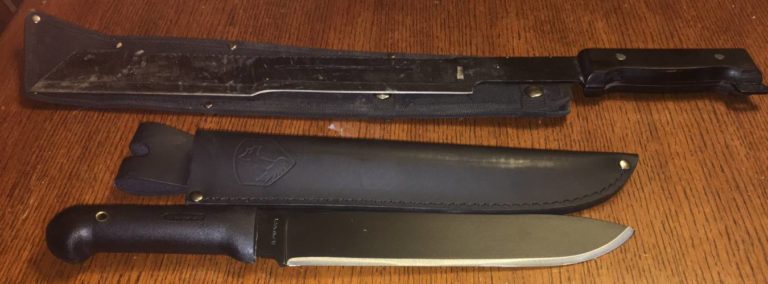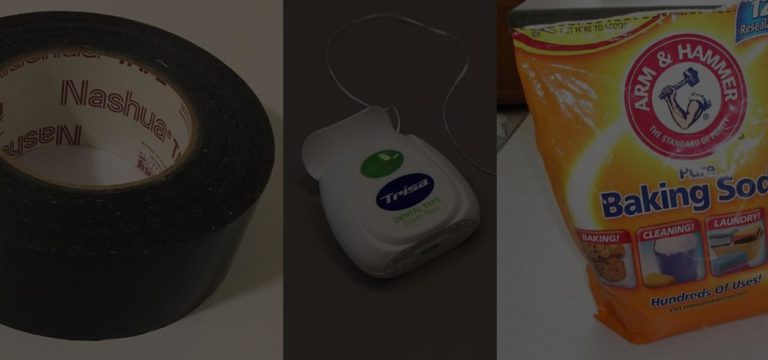Redundancy in your Bug-Out Bag
I learned about the importance of redundancy in my bug-out bag very early in my survival career. I was on a hike scouting out an area for a survival challenge and testing some gear. The only tool for starting fire I had brought with me was a ferro rod. It was attached to the handle of my machete with one of those old cheap keyrings that you sometimes see dangling from a ceiling fan. I thought for sure that it would be a good way to keep from losing it. I was wrong.

I started out through the thick brush chopping and hacking as I went. I was both clearing my path and blazing a trail so I would not lose my way. I finished my scouting trip with about 30 minutes of daylight left and started to head back. That is when I noticed that the ferro rod and the keychain were gone. I had not felt it fly loose and had not seen that it was missing. This is when panic started to set in. I decided to search the trail for the metallic ferro rod in hopes that the metal might flicker in the setting sun giving away its position.
The vegetation on the forest floor was thick, and I went back over every inch. I was having no luck and the sun was almost gone behind the horizon. Now I had no way to start a fire, and no light to help me get back home. I had not brought a flashlight with me thinking I would surely be home well before dark. I finally gave up on the search and headed back. Thankfully I was able to find my way and make it back safely. I would not make the same mistake again.
Redundancy in a bug out bag is a bit like having a backup plan for your backup plan…
There are certain functions that you can accomplish because of the items in your bug out bag. In order to be sure you can complete those tasks, it is important to avoid relying on just one item for that task. There are times when a single item in your pack being lost or broken could mean the difference between life and death.
A huge factor in survival is adaptability. In every single survival challenge I have completed, at least one thing did not go as planned. There is always a curve ball coming your way when you are dealing with Mother Nature. To truly be prepared for a survival situation, you must be prepared to improvise. Improvisation is not just a concept that is either executed or not executed. It is a skill that must be developed. The only way to do that is through practice. Part of that improvisation is having the tools needed to improvise.
How to Make Redundancy Effective
The first step in this process is to acknowledge that redundancy in your bug out bag is needed. However, to maximize the effect on your chances of survival there are some specific strategies to employ. One is to have variety in your redundancy. Each item in your bug out bag has advantages and disadvantages. Therefore, having several items that are identical is not as effective as having several different items that accomplish the same task.
Disclosure: when you click a link leading to a 3rd party website, I may earn a commission if you make a purchase. As an Amazon Associate I earn from qualifying purchases.
For example, having a lighter, a ferro rod, and a fire lens is much more effective than just having three lighters. What happens if your pack gets waterlogged or if you are forced to survive for months on end? A waterlogged lighter is worthless. Your ferro rod and lens will still work when wet. In addition, eventually the fuel in your lighters will run out. The ferro rod and fire lens do not require fuel. Can you see how variety in your redundancy works much better when SHTF?
Another strategy to employ when adding redundancy to your bug out bag is to vary the locations of the items. If you have all of your items in the same compartment of the same bag, you could be setting yourself up for disaster. Let us say your bag has a primary compartment that is waterproof and a front pocket that is not waterproof. Perhaps you bring a zippo, a Bic lighter, and matches but you keep them in the outer pocket for convenience. If the bag gets doused in water, the redundancy is worthless. However, if you keep one item in the outer pocket, one in the primary compartment, and one in your jacket pocket, you reduce the risk of disaster.
I like to keep a few smaller packs inside my large pack. This way I could take one small pack with me if I needed to shed some weight and still have the essential items I need for survival. I also like to have items on my person in case my pack gets lost or stolen. My goal is to always have the essential elements required for survival available to me no matter what happens.
Categories for Redundancy
There are four pillars of survival that are needed to make it through a SHTF scenario. They are food, water, fire, and shelter. These are the musts on which you should focus first. Then as secondary priorities you have first aid, orienteering, self-defense, and signaling for help. In a perfect world, you want to have levels of redundancy for all eight of these categories. Here are some ways you can accomplish this goal.
Food
When packing a bug out bag, you can provide yourself with several sources of food. The easiest it just to pack food in your bag. However, food can add a great deal of weight to your pack. You have to be careful about what you bring. Items like hardtack or jerky are lightweight and provide the carbs and protein needed to keep going. MREs (Meals Ready to Eat) are nice, but they are heavy and can be expensive.
In addition to bringing food, you want to have several ways to procure food from nature. For fishing you can pack a pocket fisherman, a fishing kit, or a gill net. You should also know how to make trotlines from cordage and fish traps from natural materials. For hunting you may want to bring a gun, bow, crossbow, or slingshot. Be aware that guns run out of bullets and make a great deal of noise. They are also quite expensive. You also should know how to build a variety of traps from both natural and synthetic materials.
Lastly, knowledge can help with your food redundancy. Knowing your wild edible plants can give you perhaps your easiest food source. There are almost always leafy greens, berries, or tubers that can keep you fed. In addition, collecting these foods requires you to expend very few calories. Just be sure you know what the plant is before you eat it.
Water
Finding water if normally not a problem, but water needs to be purified before it is safe to drink. I like to carry a water bottle with a filter built into the lid as a primary method of purification. However, I also carry a straw style filter and iodine tablets as backup plans. I have had times when my water bottle got clogged and I had to rely on the other options to survive. You should also know how to purify water with UV light, by boiling, and with a proximity well.
Fire
Arguably the most important asset in survival is the ability to start a fire. It provides warmth, light, insect repellant, predator deterrent, the ability to cook food, and the ability to purify water. A Zippo lighter is my method of choice since it is windproof, reliable, and can be refueled with several different flammable liquids. In addition, I like to keep a Bic lighter, waterproof matches, a ferro rod, and a fire lens in my pack. This ensures that I can start a fire in absolutely any conditions.

I also like to have tinder and fire assistance products with me. Char cloth is ideal for use with either a lens or a ferro rod. Wetfire cubes allow you to shave off the corner and light the pile of shavings with just one spark. You can then put the rest of the cube on the fire to keep it lit for several minutes. Firesticks require a flame but will stay lit in the wind and rain for 20 minutes. I also like to stuff a toilet paper roll with dryer lint and bring some cotton balls doused in petroleum jelly. All of these items allow you to start a fire faster when in a pinch.
As a last resort, I have a pocket butane stove that weighs almost nothing and fits in my pocket. It has a small butane tank that is about the same size and weight. This can allow me to boil water or cook food in just a few minutes with no natural materials, but it does not do much for warmth. It is ideal if you make camp after dark and cannot go looking for fire wood.

I also carry several ways to process fire wood. This includes a folding saw, pocket chainsaw, hatchet, straight saw, and a knife large enough for chopping and batoning.
Shelter
Cordage is one of the most important ingredients in a good shelter. I always keep 550 paracord on me for this use as well as others. It is also important to have cutting tools for processing wood. I like to bring a folding saw, a hatchet, a pocket chainsaw, and a knife large enough to chop small poles. Having a thick emergency blanket or a tarp can be very helpful when building a waterproof shelter. Also, during winter months I bring a small, one person backpacking tent, a sleeping bag, and a sleeping mat. They add a great deal of weight, but would keep me protected down to -5F.

Other
For orienteering I typically have a compass, my cell phone, and a survival bracelet with a compass built in. I also know several other ways to find my direction without man made materials.
For signaling I keep a signal mirror, have a whistle built into my survival bracelet, have my cell phone, and know several ways to signal for help without man made materials.
For first aid I carry a small first aid kit, a needle and thread for stitching wounds, quick clot for gunshot wounds, and know several ways to improvise first aid.
For self-defense you can carry a gun, bow, or crossbow. I have a few knives of various sizes in my pack. I keep a tactical pen with me for close combat, and I know enough self-defense to use my hands if needed. I also typically will turn a walking stick into a spear for self-defense and hunting. You can carry pepper spray or a stun gun if you feel the need.






